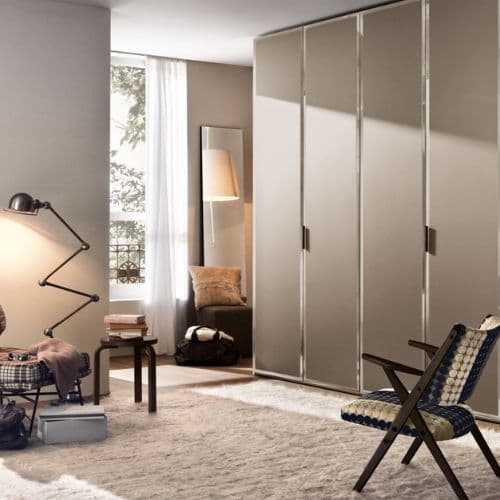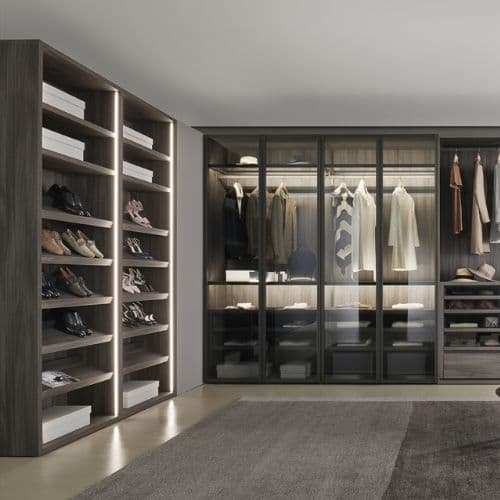Written by: Zoona Sikander, Interior Design Writer & Social Media Content Creator
Edited by: Emma Cyrus, Senior Copy, Content & Editorial Writer
Reviewed by: Rey Amini, Senior Interior Designer & Architect
Fact-checked by: Benjamin Ibanez, Development & FF&E Manager
With humidity being a common problem in UK homes we often get asked: How do you prevent dampness in built-in wardrobes?
While custom cabinetry is popular because of its storage efficacy, it is certainly not immune to environmental conditions that may harm your treasured possessions. However, there are some simple tips and tricks that can help ensure that your fitted wardrobes do not become moisture traps.
With 35 years of experience designing and installing these units, our experts have the inside edge when it comes to proper maintenance. So we have compiled this short guide to help you identify damp issues and the steps you can take to prevent or treat them.
Read on to find out more.

Damp refers to the presence of moisture on the surfaces in your home such as your walls, windows and ceilings.
When it comes to wardrobes, this comes from two main culprits: condensation (often from steam in your en suite), and clothing that has not properly been dried before hanging.
Having dampness in your cupboards is problematic and often leads to mould and mildew, which will not only ruin your garments but are also unsightly and unhealthy.
Unfortunately, from corner units like Logo’s Design #30 to glass-fronted doors like Rugiano’s Zelo offering, most fitted wardrobes are not exposed to fresh air. This causes moisture to build up over time. It is therefore important to make sure that these conditions are properly combatted.
Here are some options on how to do it:
When planning your storage expansion, consider the placement of your cabinetry to ensure that it’s in the best possible space for optimal maintenance. Our design team would be happy to explore your options with you.
Ideally, every corner of your home should smell fresh, so if your built-in wardrobe starts giving off a distinctive musty odour, you probably have a damp problem.
Moisture will show up on your cupboard walls as dark marks or, if it's on plaster, discolouration. You may also notice the peeling of paint or curling of wallpaper away from the wall in the areas where the wetness is collecting.
In the absence of visual signs, damp walls are cold to the touch so if your internal walls seem chillier than normal, it is time to sound the alarm.
.jpg)
.jpg)
The first step to stopping the spread of mould is to remove the existing signs of it. However, it’s important to avoid using harsh chemicals which may damage your wardrobe finishes, especially if they are painted like the Armadi options from Furbambini. These are our suggestions:
If the damage from mould and dampness is extensive, you may need to consider a rebuild. At FCI London, our professional design and joinery team will provide the full process from conception to installation, taking into account your ventilation needs.
These easy tips will help keep your wardrobe mould-free:
Good ventilation and moisture control are key to preventing dampness in your built-in wardrobes and keeping your belongings safe from any damage.
However, if you’re investing in new cabinetry, consult with a professional company to ensure that it is built with all the right measures in place.
At FCI London we have all the experience you need to create the wardrobe of your dreams and offer a vast range of customisation options to boot. To find out more, get in touch today or pop into our showroom for a free design consultation.
Get In Touch
Book A Video Chat
Book a video consultation and we'll advise you on furniture, space planning, colour schemes and much more.
Book A ConsultationVisit Our Showroom
Book a visit to our stunning, multi award-winning, 30,000 sqft.
Over 700 brands under 1 roof.








Most Popular on FCI London: Fitted Wardrobes | Luxury Designer Rugs | Luxury Sofas | Luxury Furniture Store | Luxury Interior Designers | Luxury Bedroom Furniture | Luxury Modern Chairs | Luxury Coffee Tables | Luxury Designer Kitchens | Luxury TV Units | Luxury Dining Tables | Luxury Storage Solutions | Luxury Sideboards | Luxury Stools & Bar Stools
Transparency's kind of our thing.
Here's what real customers have to say about us.
